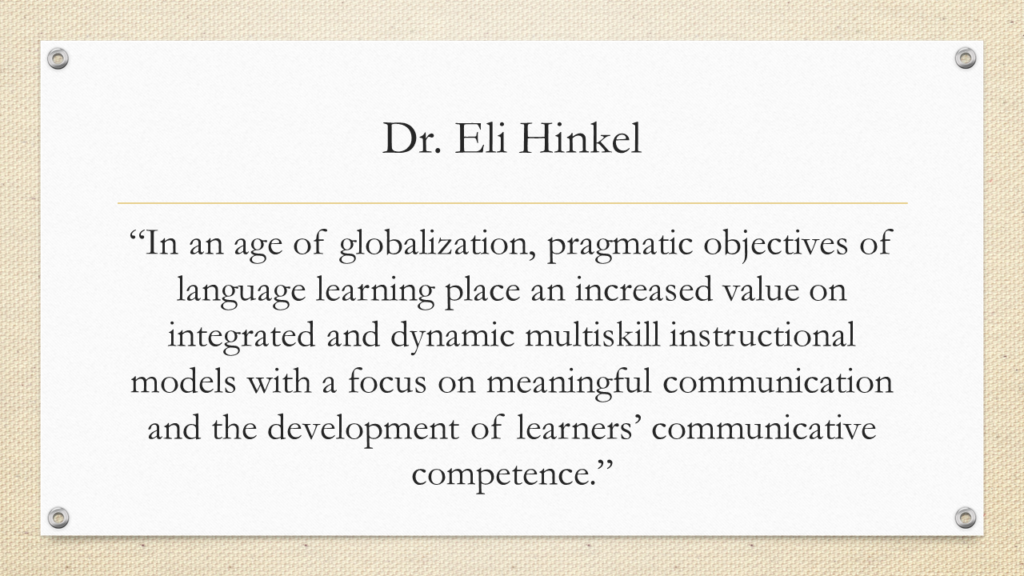In an ESL classroom, students engage in tasks designed to enhance communicative competence. Communication can take place in many forms, sometimes linguistic, sometimes not. At Georgia Tech, English 1101/1102 courses explore the many facets of communicative competence, including oral, written, and visual modes, etc.).

Some students enroll in these courses with high aptitude in some areas, while lacking in others. They might excel in oral communication tasks, such as debate or public presentations, but struggle with written tasks, such as proposals or essays. At times, their struggle stems more from a lack of familiarity or exposure to cultural conventions for communication rather than linguistic elements. The goal of these courses is to help students become well-rounded in their communicative competence, developing their knowledge and dexterity with the components and conventions of multiple communicative modes, their awareness of potential audiences and their expectations, and the tools required in producing and shaping communication in a given situation.
While each of the modes previously mentioned represents some aspect of communicative competence within a multimodal framework, the primary modes of ELL linguistic input and output (what H. Douglas Brown calls “receptive performance” and “productive performance”[284]) have traditionally been subdivided into what ESL instructors and scholars have referred to as “the Four Skills”: reading, listening, writing, and speaking. These areas provide the basis for linguistic interpersonal communication.
Evaluating a student’s proficiency in these areas can help teachers understand and scaffold their students’ communicative needs, create assignments concentrating on those areas of concern specifically, or simply direct them toward resources capable of optimizing the students’ potential for success. A student may excel in one area and not in others, but that one proficient area can provide an instructor with the false impression that the student’s overall proficiency is higher than it truly is. For example, some students are advanced speakers, but require additional assistance with writing. If such a student struggles with class assignments, it might be worth the instructor’s time (perhaps through conferencing or conversations) to examine whether the student’s mastery of one mode in this academic context has masked a lack of proficiency in other areas.
For example, the teacher talks to the student in class about the assignment. The student articulates a solid idea. Everything seemed clearly laid out with mutual understanding on both sides. Then the student turns in a draft falling well below the teacher’s expectations. What happened?
- If a student’s listening comprehension is low, could that be the reason they did not understand your explanation of an assignment?
- If a student’s writing ability is weak, would that explain the lack of clarity in their argument and the many syntactical and lexical errors?
- If a student is not a strong reader, might they have missed some of the nuances in the readings to which their essay was responding? Would it also explain the lack of research in the essay because they could not read scholarly articles quickly enough to put together a solid critical foundation?
Hopefully, such conversations can lead the teacher to direct the students to appropriate resources or break communication tasks into more manageable steps, thus providing students with a higher potential level for success.
Because the demands of everyday interactions, whether in a classroom or in a Costco, often require that we use these communicative skills “in tandem” (Hinkel 113), ESL instructors should not only create tasks that lead students to generate input and output in these different areas, but should also consider intentionally adopting an integrated or “whole language” approach that treats these skills as mutually reinforcing and inter-related (Brown 284). In a 1991 article, for example, John M. Murphy writes about the need to integrate “speaking, listening, and pronunciation…within the broader context of oral communication,” and Murphy provides ideas and activities that can help ESL instructors create situations in which these skills build upon and reinforce each other in the classroom (61).
 Many instructors are already integrating the “Four Skills” in their class, in different ways and perhaps without even realizing it. In English 1101/1102 courses at Georgia Tech, instructors may assign students to read a particular textbook chapter before coming to class. In class, students might take a few minutes to write down some thoughts about the reading on a separate piece of paper or in the margins of the reading itself, all in anticipation of an oral discussion they will have with their classmates and instructors. They will listen to the points made by others and respond orally with their own. Because students in general, not only English language learners, tend to lean more heavily on the things they know they do well than the areas where they struggle, a whole language or integrated approach can encourage students to develop in those weaker areas.
Many instructors are already integrating the “Four Skills” in their class, in different ways and perhaps without even realizing it. In English 1101/1102 courses at Georgia Tech, instructors may assign students to read a particular textbook chapter before coming to class. In class, students might take a few minutes to write down some thoughts about the reading on a separate piece of paper or in the margins of the reading itself, all in anticipation of an oral discussion they will have with their classmates and instructors. They will listen to the points made by others and respond orally with their own. Because students in general, not only English language learners, tend to lean more heavily on the things they know they do well than the areas where they struggle, a whole language or integrated approach can encourage students to develop in those weaker areas.
If you are interested in learning more about ESL scholarship on “the Four Skills,” feel free to search in the nested pages where you will find a series of citations and annotations related to scholarly contributions on the areas of reading, writing, listening, and speaking.
Bibliography
Brown, H. Douglas. Teaching By Principles. Pearson, 2007.
Hinkel, Eli. “Current Perspectives on Teaching the Four Skills.” TESOL Quarterly, vol. 40, no. 1, pp. 109-31. JSTOR, https://www.jstor.org/stable/40264513. Accessed 11 Jan. 2019.
